9 types of oral pathology
Can you identify these common anomalies?
When performing a thorough oral examination, you may encounter many anomalies. It is important that you recognize these common problems, record them on the dental charts, and bring them to the veterinarian’s attention. Identifying problems at this stage ensures that the patient receives the best and most timely treatment.
1. Stomatitis
Stomatitis is a chronic, painful condition that can be difficult for veterinarians to treat. Stomatitis is defined as inflammation of the oral mucosa, including the buccal and labial mucosa, palate, tongue, floor of the mouth, and gingival tissues. The inflamed tissue may appear swollen and bright red with a cobblestone- or raspberry-like texture. The tissue bleeds easily, and the mouth is painful. Multiple tests, including dental radiographs, routine blood work, and tissue biopsy, are recommended to search for an underlying cause. It is important to ensure that feline patients are negative for the feline leukemia and feline immunodeficiency virus infections, and you may want to consider Bartonella species testing. Some evidence indicates that stomatitis is immune-mediated.
Stomatitis is often difficult to resolve, and the treatment may be aimed at controlling the clinical signs and associated discomfort. Complete dental extraction, including the removal of all the dentin, has been shown to be the most effective treatment. It is important for veterinarians or technicians to thoroughly discuss the treatment options, length of treatment, and potential outcomes with the client.
2. Tooth resorption
Tooth resorption is a common condition in cats. Some studies indicate that up to 50 percent of cats are affected. It occurs less frequently in dogs. These lesions have been called neck lesions, cervical line lesions, cat cavities, and feline odontoclastic resorptive lesions. Tooth resorption is a progressive disease and can elicit a pain response in affected cats. Behavioral signs commonly associated with tooth resorption include chewing on one side of the mouth, decreased appetite, dropping food, hissing at food or water bowls, hiding, or increased aggression. Tooth resorption can be difficult to classify, and dental radiography in combination with a thorough dental examination while the patient is anesthetized is needed for the veterinarian to make a diagnosis.
The five stages of tooth resorption are determined by the amount of crown involved in the lesion.
- Stage 1 = Lesions extend only into the cementum. This stage occurs only subgingivally and may be difficult to detect.
- Stage 2 = Lesions progress through the cementum into the dentin of the root or crown, but the pulp is not exposed. Hyperplastic gingiva may cover these defects.
- Stage 3 = Lesions progress into the pulp chamber. Bleeding on probing and spontaneous fractures of the crown may occur.
- Stage 4 = Lesions destroy a significant amount of the crown.
- Stage 5 = Lesions have significant root replacement resorption with healing of the gingiva. There will not be any clinically apparent tooth tissue.
These lesions can also be classified into three types based on the radiographic appearance of the periodontal ligament space.
- Type 1 = Lesions are caused by inflammation. The root appears normal, and the periodontal ligament space is still observable.
- Type 2 = The affected tooth is ankylosed to the alveolus. This type of lesion is not associated with periodontal disease.
- Type 3 = The affected tooth has one root with Type 1 tooth resorption and one root with Type 2.
3. Chronic alveolar osteitis
This condition, commonly associated with the maxillary canine teeth in cats, produces a pronounced bulge of the osseous tissue at the upper canines (Photo 1).

1. Alveolar osteitis in a cat. Note the deterioration of the bone in the right maxillary canine. Chronic inflammation has changed the integrity of the bone, causing the bulging appearance.
Suspicious tissue should be biopsied, but, in most cases, this condition is the result of chronic inflammation. Periodontal pockets may be present, and the periodontium and tooth structures should be treated appropriately. Sufficient inflammation and loss of attachment may warrant extraction.
4. Maxillary canine extrusion
Cats may have maxillary canine teeth that appear to extrude, a condition that can occur alone or be in conjunction with chronic alveolar osteitis (Photo 2).
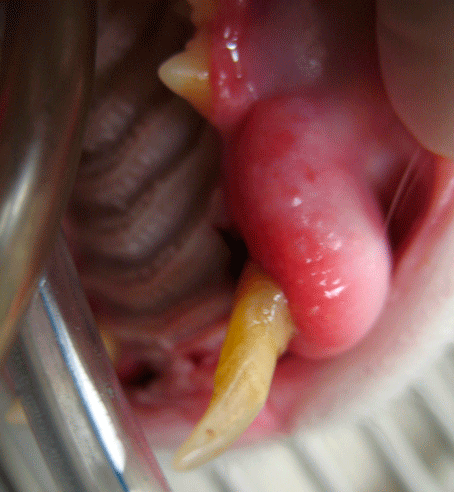
2. This is an extreme case of alveolar osteitis and canine extrusion. This cat’s maxillary canine tooth was extremely mobile because of the extent of the extrusion present.
The teeth are longer than normal and have an increased amount of gingival recession. The extruded teeth may cause trauma to the lower lip. If the tooth is not mobile and does not have periodontal pockets or radiographic signs of excessive bone loss, it can be saved. It may be necessary for a veterinarian to blunt the tips of these canine teeth to minimize associated mandibular lip trauma.
5. Discolored teeth
It is important to note any discolored teeth on the dental chart so that the veterinarian can thoroughly evaluate whether the discoloration is due to extrinsic or intrinsic staining. Extrinsic staining is caused by accumulations on the tooth surface. Intrinsic stains are secondary to endogenous factors that discolor the underlying dentin and typically indicate damage to the vital pulp tissues (Photo 3).
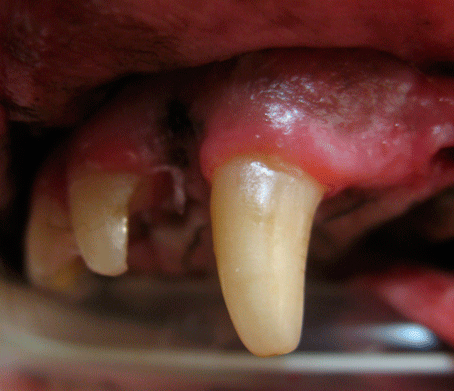
3. This dog's left maxillary canine tooth demonstrates intrinsic discoloration. This condition is caused by trauma to the tooth. As the pulp chamber is damaged, blood is released into the tubules, causing the discoloration.
Transillumination with a fiberoptic light can assist in distinguishing between vital and necrotic pulp. Radiographs of the affected teeth can also be useful to the veterinarian in identifying pathology associated with discolored teeth.
6. Malocclusions
Bite evaluation entails more than just observing the incisor relationship. It is critical that you evaluate the entire bite. Any variation from the standard occlusion is considered a malocclusion.
A normal occlusion is called a scissors bite. The lower incisors occlude next to the lingual surface of the upper incisors. The lower canine teeth fit evenly between the upper canine and the third incisor. Premolars are in a pinking shears configuration in which the cusps of the mandibular premolars point toward the interdigital spaces of the maxillary premolars with the cusps overlapping in a horizontal plane, and the upper and lower arches are symmetrical. The four classifications of malocclusions, recently updated by the American Veterinary Dental College, are neutroclusion, mandibular distoclusion, mandibular mesioclusion, and assymetrical skeletal malocclusion.
Neutroclusion: A normal maxilla and mandible relationship with malposition of one or more individual teeth.
- Rostral crossbite (formerly known as anterior crossbite) is a common malocclusion in which one or more of the lower incisors are labial to the opposing maxillary tooth. The upper incisors and the rest of the teeth occlude normally.
- A level bite is an abnormal occlusal pattern in which the upper incisors match cusp to cusp. It can be extremely punishing to the incisors, resulting in premature wear and a predisposition to periodontal or endodontic disease.
- Linguoversion (formerly known as base narrow) is lingually displaced canine teeth, which can result in the tips of the mandibular canine teeth protruding into the hard palate.
- Labioversion or rostrally angled maxillary canine teeth (formerly known as lance canines), can be unilateral or bilateral and are most frequently seen in Shetland sheepdogs, although it can occur in any dog breed and in cats. The maxillary canine tooth erupts at an angle, creating interference with the mandibular canine teeth.
- Caudal crossbite (formerly known as posterior crossbite) is an abnormal occlusion in which one or more mandibular premolars or molars are buccal to their opposing maxillary teeth.
Mandibular distoclusion (overbite): Either the mandible is short in relation to the maxilla or the maxilla is too long (Photo 4).
.

4. This 5-month-old Shih Tzu presented with an extreme mandibular distoclusion. The distance between the maxillary incisors and the mandibular incisors was 32 mm.
Other terms commonly used are overshot, overbite, parrot mouth, reverse scissors bite, retrusive mandible, and distal mandibular excursion. Note mandibular distoclusion on the dental chart.
Mandibular mesioclusion (underbite): The mandible can be too long in relation to the maxilla, but more often, the maxilla is too short (Photo 5).

5. A case of mandibular mesioclusion in a dog with a mesiocephalic skull type. Note that tooth 404 should rest between teeth 104 and 103. The mandibular incisors are significantly in front of the maxillary incisors.
Other terms commonly used are undershot, protrusive mandible, and mesial mandibular excursion. This malocclusion is a characteristic of certain breeds, such as boxers, bulldogs, and Persian cats. Note mandibular mesioclusion on the dental chart.
Assymetrical skeletal malocclusion (formerly known as wry bite) is when one quadrant experiences abnormal growth—either too long or too short—and the midline is altered (Photo 6).

6. This is the same dog as in Photo 5. Note that the midline of the maxillary and mandibular incisors in the width of one incisor is off center.
This malocclusion is reported to be genetically transmitted and can result in a variety of different jaw relationships. It can also be caused by trauma to the muzzle at an early age.
7. Oral and gingival masses and other irregularities
You should draw all oral masses onto the dental chart. It is important to record these in order to have a record of the mass and be able to note changes during future examinations or gingivectomies (the removal of loose, infected, or diseased gingival tissues) (Photos 7-9).

7. A 5-year-old boxer with an oral mass on the maxilla. Gingival hyperplasia or overgrowth is common in boxers.

8. Gingival hyperplasia in the maxilla of an 8-year-old boxer.

9. A oral mass discovered in the sublingual tissue of a dog. This demonstrates the importance of visualizing all the tissues on the oral cavity.
Examine sublingual tissues for abnormalities or foreign bodies. Inflammation of the tongue, or glossitis, can be present because of viral infections, immune-mediated problems such as lymphocytic-plasmacytic stomatitis, autoimmune problems, or toxicosis from irritative substances.
Gum chewers lesions are caused by self-inflicted trauma as a result of the patient chewing on the inside of the cheek or tongue. These lesions cause proliferative, granulomatous hyperplasia. The lesions can be mild to serious, involving large amounts of tissue that can result in regular hemorrhages, and may be painful.
Squamous cell carcinoma is the most common malignancy in the oral cavity of cats, followed by fibrosarcoma. Malignant melanomas are rarely seen in cats. In dogs, the most common oral tumor type is melanosarcoma; fibrosarcomas, and squamous cell carcinomas are also common. While squamous cell carcinoma can be found almost anywhere in the oral cavity, those that are located further rostrally have a better prognosis. Melanomas can be found in the gingiva, mucosa, palate, and tongue and tend to be the most aggressive tumors in the oral cavity (Photo 10).

10. This 11-year-old mixed-breed dog was presented for blood in its food bowl. An oral exam revealed a large oral mass that was diagnosed as oral melanoma.
Often, melanomas have metastasized by the time they are detected. Fibrosarcomas can have a high rapid local invasion into bone but are usually slow to metastasize. The maxillary gingiva and palate are the most common sites for these tumors. The clinical characteristics of these tumors are not diagnostic. Biopsy is the only way to confirm a diagnosis of oral neoplasia.
8. Oronasal fistulas
In maxillary teeth, the width of the alveolar bone between the teeth and nasal cavity or sinus is often thin, especially in long-and-narrow-nosed dogs such as dachshunds (Photo 11).
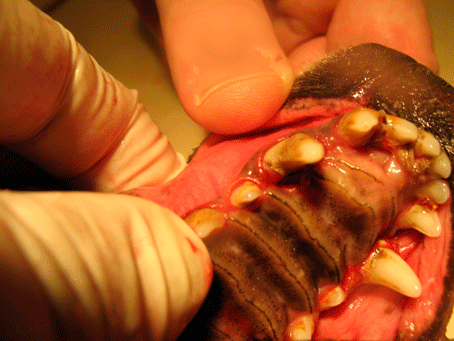
11. An oronasal fistula on the palatal aspect of 104 in a 6-year-old dachshund. After probing, blood will be visible from the nose if a fistula is present.
Any opening, no matter how small, provides a direct pathway to the nasal sinus through which bacteria and other debris travel, often causing chronic infection. These fistulas can go undetected because they are most commonly located on the palatal surface of the canines. On periodontal probing, an extremely deep pocket on the palatal aspect of the canine is evidence of the fistula. After probing, blood will be visible from the nose if a fistula is present. Oronasal fistulas require surgical repair.
9. Draining tracts and fistulas
Bone loss, retained root tips, and periapical lesions are just a few of the problems that can lead to draining tracts (Photos 12-14).
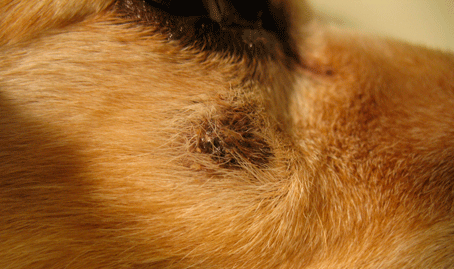
12. A chronic abscess of a carnassial tooth can result in a draining tract below the eye.
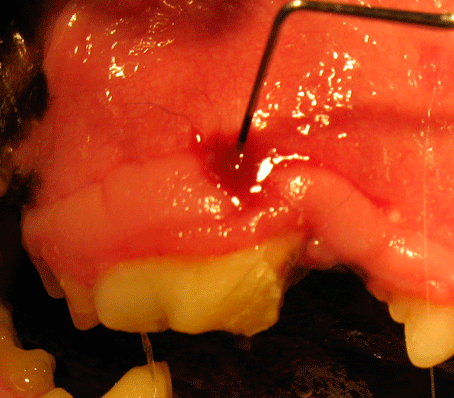
13. A fistula on a fractured maxillary canine in a 7-year-old Laborador retriever.
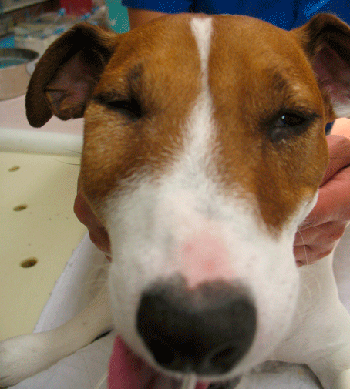
14. This 5-year-old Jack Russell terrier presented for facial swelling. An oral examination revealed a fracture on 104 leading to an abscess.
Thus, it is important to note these lesions if identified on radiographs. These fistulas are usually visible externally by a wound on the muzzle below the eye.
Other abnormalities
Record on the dental chart any rotated, supernumerary, fractured, missing, or extracted teeth; any tooth crowding; and the attrition or wear of teeth because of an improper bite. With fractured teeth, it is critical to record the type of fracture. Also, note any retained deciduous teeth since they will likely require extraction.
RECOMMENDED READING
1. Logan EI, Boyce EN. Oral health assessment in dogs: parameters and methods. J Vet Dent 1994;11(2):58-63.
2. Harvey CE, Emily PP. Periodontal disease. In: Harvey CE, Emily PP, eds. Small animal dentistry. St. Louis, Mo: Mosby, 1993.
3. Logan EI, Finney O, Hefferren JJ. Effects of a dental food on plaque accumulation and gingival health in dogs. J Vet Dent 2002;19(1):15-18.
4. Holmstrom SE. Veterinary dentistry for the technician and office staff. Philadelphia, Pa: WB Saunders Co., 2000.
5. Gorrel C. Veterinary dentistry for the general practitioner. Philadelphia, Pa: Saunders, 2004.
6. Lobprise H. Five-minute consult clinical companion: small animal dentistry. Ames, Iowa: Blackwell, 2007.
Mary Berg, BS, RVT, RLATG, VTS (dentistry), is the practice manager and dental specialist at Gentle Care Animal Hospital in Lawrence, Kan. She is also president of MLB Consulting, a veterinary dental consulting company.